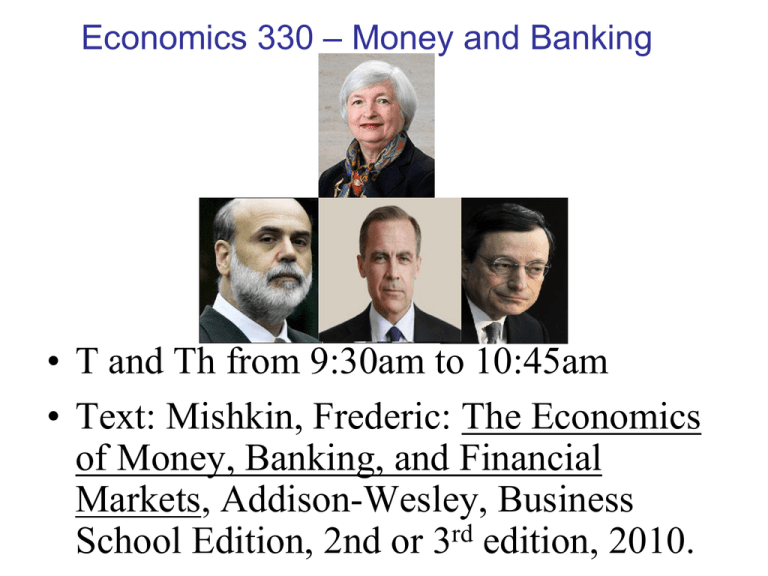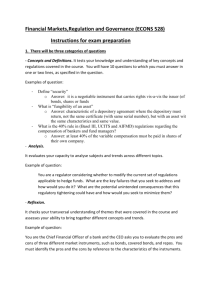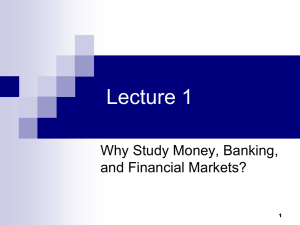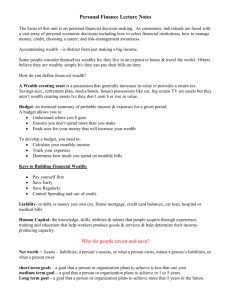
Economics 330 – Money and Banking
• T and Th from 9:30am to 10:45am
• Text: Mishkin, Frederic: The Economics
of Money, Banking, and Financial
Markets, Addison-Wesley, Business
School Edition, 2nd or 3rd edition, 2010.
Who am I ?
• Dr. John Neri
• Office Hours: T and Th from 3:30pm to
4:30pm.
• Office: Morrill Hall, Room 1102B
Who you are: (182 students) as of 1/19/15
•
•
•
•
•
•
•
•
•
Accounting – 13
Computer Science – 10
IAP - 18
Economics - 50
Finance – 27
G&P–6
Intl. Bus - 2
Marketing – 8
Math/Math Stat - 4
MGMT - 4
Undecided - 26
Course Webpage
• http://www.terpconnect.umd.edu/~jneri/Econ330
NOTE: upper-case E
Can you define each of the following?
• Federal Reserve System
• MBS
• FOMC
• Money Market
• Federal Funds
• Capital Market
• Federal Funds Rate
• Sub-prime Mortgage
• Discount Loan
• QE 4
• Discount Rate
• Shadow Banking System
• Open Market Operation
• MMMF
• Quantitative Easing
• Large Scale Asset
Purchase
QE 1, 2 and 3
• Operation Twist
What is this?
Why Study Money, Banking, and
Financial Markets?
Chapter 1
Why Study Money, Banking & Financial Markets
• To understand how financial markets work
- Obviously, there are many financial markets.
- We focus primarily on bond and credit markets
• To examine how financial institutions work
- Many types of financial institutions
- We focus primarily on commercial banks
• To examine the role of money in
the economy
- How the Federal Reserve System works
Five Parts of the Financial System
1. Money
An asset used to pay for purchases, repay
of debt, pay taxes
- a store of wealth
- a medium of exchange
2. Financial Instruments
Used to transfer wealth from savers/lenders
to investors/borrowers and to transfer risk
to those best equipped to bear it.
Five Parts of the Financial System
3. Financial
Markets
Allow us to buy and sell financial instruments
quickly and cheaply.
Funds are transferred from people who have an excess
of available funds to people who have a shortage of
funds
4.
Financial Institutions.
Firms that provide access to financial markets
Five Parts of the Financial System
5. Central Banks
monitor and stabilize the economy,
monitor financial institutions.
Well Functioning Financial System
Promotes Economic Efficiency
• Facilitate Payments – commercial
bank checking accounts
• Channel Funds from Savers to
Borrowers
• Enable Risk Sharing - Classic
examples are insurance and forward
markets
The Bond Market and Interest Rates
• A bond is a debt security that promises to make
payments periodically for a specified period of
time
A security (a financial instrument) is a claim on the
issuer’s future income or assets
• The interest rate is the cost of borrowing.
Price paid for the rental of funds, expressed as a
percentage.
Pay $5.00 to rent $100 for one year - 5.0% interest
Interest Rates on Selected Bonds, 1950–2015
Three things this graph demonstrates??
3-month Bill
10-year Treasury
10-year Corporate Baa
Copyright © 2007 Pearson Addison-Wesley. All rights reserved.
1-15
The Stock Market
• Common stock represents a share of
ownership in a corporation
An equity security (financial instrument) that is a
claim on the earnings and assets of the corporation
Residual claim
• Firms can issue new shares to finance
investment spending
Shiller: Real Terms. Note the behavior of price relative to
earnings. Mishkin starts at 1950.
Financial Institutions and Banking
• Financial Intermediaries: institutions that
“borrow funds from” (“issue liabilities to”)
people who save and make loans to other
people:
Commercial Banks: accept deposits and
make loans
Other financial institutions: insurance
companies, finance companies, pension
funds, mutual funds and investment
banks
Commercial Banks
Loans
deposits
Pension Funds
Stocks
Retirement
Plans
Insurance Companies
Bonds
Stocks
Insurance
Policies
Mutual Funds
Bonds
Stocks
Shares
Money Market
Mutual Funds
Commercial Shares/
paper
“deposits”
T-Bills
Money and Economic Activity
(Business Cycles)
• Evidence suggests that money plays an
important role in generating business
cycles
Recessions and expansions in economic
activity
• Monetary Theory ties changes in the
money supply to changes in aggregate
economic activity and the price level
Money Growth (M2 Annual Rate) and the Business Cycle in
the United States, 1950–2008
Note: Shaded areas represent recessions.
• The aggregate price level is the average
price of goods and services in an economy
A continual rise in the price level is inflation affects all economic players
• Data shows a connection between the
growth in the money supply and the rate of
inflation
Average Inflation Rate Versus Average Rate of Money
Growth for Selected Countries, 1997–2007
Source: International Financial Statistics.
Examples of Hyperinflation:1980s and
Early 1990s
M2 Money Growth and Inflation - US
Money and Interest Rates
• Prior to 1980, the rate of money
growth and the interest rate on longterm Treasury bonds were closely
tied
• Since then, the relationship is less
clear but the rate of money growth
is still an important determinant of
interest rates
FIGURE 6 Money Growth (M2 Annual Rate) and Interest
Rates (Long-Term U.S. Treasury Bonds), 1950–2008
Inflation and Nominal Interest Rates
Mankiw
Inflation and Nominal Interest rates












